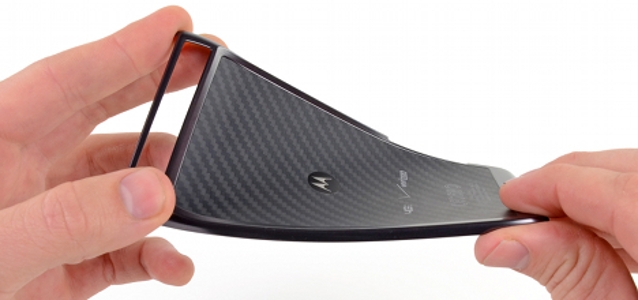
© iFixit
Business |
Motorola Droid RAZR Teardown
A recent Verizon commercial depicted the Droid RAZR as being able to cut through lamp posts with ease. We figured it would be an excellent replacement for our katanas, which we used specifically for lamp-cutting in the past.
Sadly, the phone didn't function as promised -- so instead we investigated how Motorola managed to package all of the RAZR's technology into such a thin frame.
We found the RAZR's slim figure was also its downfall. Motorola had to sacrifice repairability in order to attain that slim profile, and consequently the RAZR received a meager 4 out of 10 repairability score. Attribute that to lots of adhesive used throughout the interior, a fused LCD to the front glass, and a tedious (and at times heart-fluttering, should you hear the plastic creaking) disassembly process.
 Teardown highlights:
The RAZR measures in at a mere 0.28 inches thick, but increases to 0.42 inches at the prevalent camera bulge. For comparison, Verizon bragged back in September that the Droid Bionic was the slimmest 4G LTE phone at 0.43 inches thick.
How can something that provides so much rigidity bend so much? The thin plastic back cover, mated with the woven Kevlar, provides tough (yet flexible) protection for the internals. With the tensile yield strength of Kevlar being on par with some steels, the back case is the least of our worries as far as critical future repairs go.
Just because the cover is made from Kevlar doesn't mean it's bulletproof. Ballistic vests feature layers upon layers of tightly woven Kevlar, as well as a large ceramic plate. Long story short, don't shoot your Droid RAZR and expect it to survive.
The Droid RAZR is equipped with two liquid damage indicators: one on the bottom and one on the right side of the phone. Motorola / Verizon will definitely know if you tried to test the water-proofiness of the phone.
It's quite the ordeal for removing the battery, but at least you don't have to rip apart the entire device. Instead of the traditional battery connector socket or soldered wires found in other phones, the Droid RAZR utilizes contact points for its battery connector.
The battery comes with a handy "remove battery" tab should you ever want to replace it. At least that part of the procedure is easy.
Measuring in at 3.79" long, 2.25" wide, and .110" thick with a capacity of 1750 mAh, the battery provides over 300 mAh more capacity than that of the iPhone 4S.
We peeled off the plastic cover from the perimeter of the rear-facing camera to reveal a hidden screw near the flash LED. Sneaky, sneaky Motorola.
How extreme are the space constraints inside a device this thin? (http://bit.ly/razr_qrtr) From bottom to top, you can see the glass, display, motherboard, motherboard chips, and then a U.S. quarter stacked on top. The quarter was not found inside the RAZR, but is merely shown for thickness purposes -- so don't open your phone with the intent of finding some dough.
The majority of the hump on the top of the phone is attributable to the boxy 8 MP camera. It's a size constraint that many "thin is in" phone manufacturers are struggling to work around.
Teardown highlights:
The RAZR measures in at a mere 0.28 inches thick, but increases to 0.42 inches at the prevalent camera bulge. For comparison, Verizon bragged back in September that the Droid Bionic was the slimmest 4G LTE phone at 0.43 inches thick.
How can something that provides so much rigidity bend so much? The thin plastic back cover, mated with the woven Kevlar, provides tough (yet flexible) protection for the internals. With the tensile yield strength of Kevlar being on par with some steels, the back case is the least of our worries as far as critical future repairs go.
Just because the cover is made from Kevlar doesn't mean it's bulletproof. Ballistic vests feature layers upon layers of tightly woven Kevlar, as well as a large ceramic plate. Long story short, don't shoot your Droid RAZR and expect it to survive.
The Droid RAZR is equipped with two liquid damage indicators: one on the bottom and one on the right side of the phone. Motorola / Verizon will definitely know if you tried to test the water-proofiness of the phone.
It's quite the ordeal for removing the battery, but at least you don't have to rip apart the entire device. Instead of the traditional battery connector socket or soldered wires found in other phones, the Droid RAZR utilizes contact points for its battery connector.
The battery comes with a handy "remove battery" tab should you ever want to replace it. At least that part of the procedure is easy.
Measuring in at 3.79" long, 2.25" wide, and .110" thick with a capacity of 1750 mAh, the battery provides over 300 mAh more capacity than that of the iPhone 4S.
We peeled off the plastic cover from the perimeter of the rear-facing camera to reveal a hidden screw near the flash LED. Sneaky, sneaky Motorola.
How extreme are the space constraints inside a device this thin? (http://bit.ly/razr_qrtr) From bottom to top, you can see the glass, display, motherboard, motherboard chips, and then a U.S. quarter stacked on top. The quarter was not found inside the RAZR, but is merely shown for thickness purposes -- so don't open your phone with the intent of finding some dough.
The majority of the hump on the top of the phone is attributable to the boxy 8 MP camera. It's a size constraint that many "thin is in" phone manufacturers are struggling to work around.
 There are a ton of chips on the front side of the motherboard. To keep the design svelte, Motorola packed pretty much everything on one side of the board. Key players include:
- Toshiba THGBM4G7D2GBAIE 16GB EMMC Flash Memory
- Samsung K3PE7E700M-XGC1 4Gb LPDDR2 RAM
- Qualcomm MDM6600 Dual-Mode Baseband/RF Transciever
- Qualcomm PM8028 Power Management IC
- Avago ACPM-7868 Quad-Band Power Amplifier
- Motorola T6VP0XBG-0001 (believed to be the LCM 2.0 LTE baseband processor)
- Texas Instruments WL1285C Wilink 7 Bluetooth/Wi-Fi/GPS
- Skyworks 77449 Power Amplifier Module for LTE/EUTRAN Bands XIII/XIV
- Toshiba Y9A0A111308LA Memory Stack
- ST Ericsson CPCAP 6556002
- Hynix H90H1GH51JMP
- Infineon 5726 SLU A1 H1118 3A126586
- Bosch 2133 C3H L1ABG accelerometer
And the back of the board? Nothing of interest, which makes sense given how tightly packed the motherboard is to the display.
The LCD is permanently mated to the glass, meaning you'll have to shell out money for both even if you shatter just the glass.
-----
As always, more can be found here. / © iFixit
There are a ton of chips on the front side of the motherboard. To keep the design svelte, Motorola packed pretty much everything on one side of the board. Key players include:
- Toshiba THGBM4G7D2GBAIE 16GB EMMC Flash Memory
- Samsung K3PE7E700M-XGC1 4Gb LPDDR2 RAM
- Qualcomm MDM6600 Dual-Mode Baseband/RF Transciever
- Qualcomm PM8028 Power Management IC
- Avago ACPM-7868 Quad-Band Power Amplifier
- Motorola T6VP0XBG-0001 (believed to be the LCM 2.0 LTE baseband processor)
- Texas Instruments WL1285C Wilink 7 Bluetooth/Wi-Fi/GPS
- Skyworks 77449 Power Amplifier Module for LTE/EUTRAN Bands XIII/XIV
- Toshiba Y9A0A111308LA Memory Stack
- ST Ericsson CPCAP 6556002
- Hynix H90H1GH51JMP
- Infineon 5726 SLU A1 H1118 3A126586
- Bosch 2133 C3H L1ABG accelerometer
And the back of the board? Nothing of interest, which makes sense given how tightly packed the motherboard is to the display.
The LCD is permanently mated to the glass, meaning you'll have to shell out money for both even if you shatter just the glass.
-----
As always, more can be found here. / © iFixit
 Teardown highlights:
The RAZR measures in at a mere 0.28 inches thick, but increases to 0.42 inches at the prevalent camera bulge. For comparison, Verizon bragged back in September that the Droid Bionic was the slimmest 4G LTE phone at 0.43 inches thick.
How can something that provides so much rigidity bend so much? The thin plastic back cover, mated with the woven Kevlar, provides tough (yet flexible) protection for the internals. With the tensile yield strength of Kevlar being on par with some steels, the back case is the least of our worries as far as critical future repairs go.
Just because the cover is made from Kevlar doesn't mean it's bulletproof. Ballistic vests feature layers upon layers of tightly woven Kevlar, as well as a large ceramic plate. Long story short, don't shoot your Droid RAZR and expect it to survive.
The Droid RAZR is equipped with two liquid damage indicators: one on the bottom and one on the right side of the phone. Motorola / Verizon will definitely know if you tried to test the water-proofiness of the phone.
It's quite the ordeal for removing the battery, but at least you don't have to rip apart the entire device. Instead of the traditional battery connector socket or soldered wires found in other phones, the Droid RAZR utilizes contact points for its battery connector.
The battery comes with a handy "remove battery" tab should you ever want to replace it. At least that part of the procedure is easy.
Measuring in at 3.79" long, 2.25" wide, and .110" thick with a capacity of 1750 mAh, the battery provides over 300 mAh more capacity than that of the iPhone 4S.
We peeled off the plastic cover from the perimeter of the rear-facing camera to reveal a hidden screw near the flash LED. Sneaky, sneaky Motorola.
How extreme are the space constraints inside a device this thin? (http://bit.ly/razr_qrtr) From bottom to top, you can see the glass, display, motherboard, motherboard chips, and then a U.S. quarter stacked on top. The quarter was not found inside the RAZR, but is merely shown for thickness purposes -- so don't open your phone with the intent of finding some dough.
The majority of the hump on the top of the phone is attributable to the boxy 8 MP camera. It's a size constraint that many "thin is in" phone manufacturers are struggling to work around.
Teardown highlights:
The RAZR measures in at a mere 0.28 inches thick, but increases to 0.42 inches at the prevalent camera bulge. For comparison, Verizon bragged back in September that the Droid Bionic was the slimmest 4G LTE phone at 0.43 inches thick.
How can something that provides so much rigidity bend so much? The thin plastic back cover, mated with the woven Kevlar, provides tough (yet flexible) protection for the internals. With the tensile yield strength of Kevlar being on par with some steels, the back case is the least of our worries as far as critical future repairs go.
Just because the cover is made from Kevlar doesn't mean it's bulletproof. Ballistic vests feature layers upon layers of tightly woven Kevlar, as well as a large ceramic plate. Long story short, don't shoot your Droid RAZR and expect it to survive.
The Droid RAZR is equipped with two liquid damage indicators: one on the bottom and one on the right side of the phone. Motorola / Verizon will definitely know if you tried to test the water-proofiness of the phone.
It's quite the ordeal for removing the battery, but at least you don't have to rip apart the entire device. Instead of the traditional battery connector socket or soldered wires found in other phones, the Droid RAZR utilizes contact points for its battery connector.
The battery comes with a handy "remove battery" tab should you ever want to replace it. At least that part of the procedure is easy.
Measuring in at 3.79" long, 2.25" wide, and .110" thick with a capacity of 1750 mAh, the battery provides over 300 mAh more capacity than that of the iPhone 4S.
We peeled off the plastic cover from the perimeter of the rear-facing camera to reveal a hidden screw near the flash LED. Sneaky, sneaky Motorola.
How extreme are the space constraints inside a device this thin? (http://bit.ly/razr_qrtr) From bottom to top, you can see the glass, display, motherboard, motherboard chips, and then a U.S. quarter stacked on top. The quarter was not found inside the RAZR, but is merely shown for thickness purposes -- so don't open your phone with the intent of finding some dough.
The majority of the hump on the top of the phone is attributable to the boxy 8 MP camera. It's a size constraint that many "thin is in" phone manufacturers are struggling to work around.
 There are a ton of chips on the front side of the motherboard. To keep the design svelte, Motorola packed pretty much everything on one side of the board. Key players include:
- Toshiba THGBM4G7D2GBAIE 16GB EMMC Flash Memory
- Samsung K3PE7E700M-XGC1 4Gb LPDDR2 RAM
- Qualcomm MDM6600 Dual-Mode Baseband/RF Transciever
- Qualcomm PM8028 Power Management IC
- Avago ACPM-7868 Quad-Band Power Amplifier
- Motorola T6VP0XBG-0001 (believed to be the LCM 2.0 LTE baseband processor)
- Texas Instruments WL1285C Wilink 7 Bluetooth/Wi-Fi/GPS
- Skyworks 77449 Power Amplifier Module for LTE/EUTRAN Bands XIII/XIV
- Toshiba Y9A0A111308LA Memory Stack
- ST Ericsson CPCAP 6556002
- Hynix H90H1GH51JMP
- Infineon 5726 SLU A1 H1118 3A126586
- Bosch 2133 C3H L1ABG accelerometer
And the back of the board? Nothing of interest, which makes sense given how tightly packed the motherboard is to the display.
The LCD is permanently mated to the glass, meaning you'll have to shell out money for both even if you shatter just the glass.
-----
As always, more can be found here. / © iFixit
There are a ton of chips on the front side of the motherboard. To keep the design svelte, Motorola packed pretty much everything on one side of the board. Key players include:
- Toshiba THGBM4G7D2GBAIE 16GB EMMC Flash Memory
- Samsung K3PE7E700M-XGC1 4Gb LPDDR2 RAM
- Qualcomm MDM6600 Dual-Mode Baseband/RF Transciever
- Qualcomm PM8028 Power Management IC
- Avago ACPM-7868 Quad-Band Power Amplifier
- Motorola T6VP0XBG-0001 (believed to be the LCM 2.0 LTE baseband processor)
- Texas Instruments WL1285C Wilink 7 Bluetooth/Wi-Fi/GPS
- Skyworks 77449 Power Amplifier Module for LTE/EUTRAN Bands XIII/XIV
- Toshiba Y9A0A111308LA Memory Stack
- ST Ericsson CPCAP 6556002
- Hynix H90H1GH51JMP
- Infineon 5726 SLU A1 H1118 3A126586
- Bosch 2133 C3H L1ABG accelerometer
And the back of the board? Nothing of interest, which makes sense given how tightly packed the motherboard is to the display.
The LCD is permanently mated to the glass, meaning you'll have to shell out money for both even if you shatter just the glass.
-----
As always, more can be found here. / © iFixit




